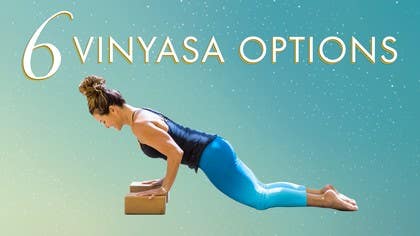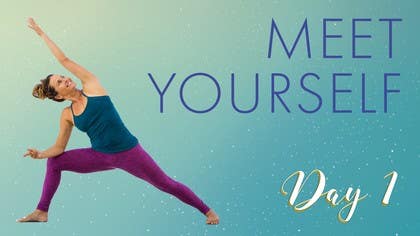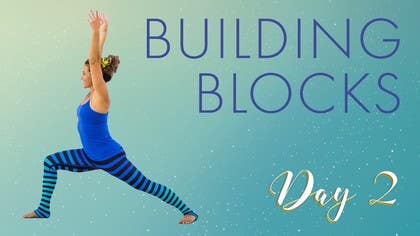Description
About This Video
Transcript
Read Full Transcript
Welcome, Michas. That means friends in Sanskrit. And speaking of Sanskrit, the word vinyasa is a Sanskrit word. And this is a little tutorial on what that means and some options to navigate our typical vinyasa inside of this challenge together. So the word vinyasa, when you break it down to your Sanskrit etymology, means to place in a special and intentional way.
Oftentimes when we hear the word vinyasa, we think of it as plank, chaturanga, up dog and down dog, as a connecting vinyasa between asana flows within ashtanga yoga, power yoga, vinyasa yoga, all these different forms and expressions of yoga in the West. But for this series, what I'd like to introduce in this little tutorial is just six different options of vinyasa that you can choose from to work with as you build strength in your practice. So you're welcome to just sit back and watch or you can do it with me, but let's just look at some options for building strength and awareness in your body and some practical applications of how to move through vinyasa. As I mentioned, you're welcome to watch this, but I'm going to teach it as if we're doing it together. So if we were to come into downward facing dog and look at the first vinyasa option that I introduced is a zigzag vinyasa.
And so it's designed to just be the kindest one to your wrist. So we inhale, shift forward to plank, and then as you exhale, you set your knees down, big toes touch, and you simply sit back in child's pose. Inhale back to hands and knees, exhale, curl the toes back to downward facing dog. So we'll do that again as we shift forward to plank. We inhale, lower the knees, exhale, child's pose becomes a nice little respite.
Inhale, hands and knees, exhale, downward facing dog. And you can see and feel the pattern in your body as you just zigzag forward, down and back, forward and up. And it creates a symmetrical pattern to connect us into whatever standing flow we're doing. The next progression would be a simple cat-cow vinyasa. And so come to your hands and knees, and this one isn't necessarily easier or harder than the zigzag vinyasa, it's just a different option, especially if you have tightness in your knees.
And it's a simple inhale as you arch, exhale to round, and I like to work with some awareness in my feet, tops of the feet flat, inhale to arch, curl the toes, and exhale back to downward dog. Let's do that again as you inhale, lightly come to hands and knees and arch, exhale tops of the feet, press around your spine, inhale arch and tuck the toes, and then back to downward dog. Let's do it once more, and the rhythm of this one is roughly about the same as the classic vinyasa. So we inhale to arch, exhale to round, inhale to arch, exhale back to downward dog. Now from here we start to pave the way towards building strength and awareness towards a full classic ashtanga vinyasa.
So as you shift forward to plank, you inhale, this is a stage one vinyasa, and we always set our knees down. And even though our knees are down, we want to keep some awareness through the core, slightly tuck the tailbone under so that when we lower down to the belly, our chest and hips meet the floor at the same time, and that requires quite a bit of strength. We inhale to cobra, take some weight off the wrist, sometimes I even lift my hands slightly, and then exhale back through hands and knees to downward facing dog. So once again a stage one vinyasa, we inhale to shift forward, lower the knees and be really conscious that you're not snaking the body down to the mat, but keeping some awareness in your core as you lower, inhale to cobra, exhale back to downward facing dog, and that's what we refer to as a stage one or a lunar vinyasa. The next progression to continue building strength would be a stage two vinyasa.
So for this one we shift forward to plank, we keep our legs straight, the core strong, and we lower through chaturanga, which is about here, we lower through chaturanga to the belly. And this is where we learn to differentiate between cobra and upward dog, so we inhale to cobra, and then exhale move your hands back a little bit, about an inch, then on your next inhale come to upward dog, so we really feel the difference here, standing in the hands and the tops of the feet, exhale back to down dog. So stage two vinyasa builds upon stage one and helps you increase your strength and awareness through the pattern. So let's inhale, shift forward to plank, shoulders are slightly forward, stay in one piece as you lower through chaturanga to the floor, inhale to your cobra, exhale move the hands back an inch, engage your quads, lift up the kneecaps, inhale upward facing dog, and then exhale back to down dog, and that's what we like to call a stage two vinyasa. So from your downward dog, come on down to your knees and let's look at stage three vinyasa, but we'll do it a couple times, and the first time we do it will be with the blocks because when we just raise the floor up a little bit with this one, it sets us up for success, especially if you have a little bit of a cranky lower back and coming into the full upward facing dog feels problematic to you, it's nice to experience it on the blocks.
We can also look at how using the blocks makes your step through a little easier when we are inside of the flow and a lot of our practices and we're stepping from downward facing dog forward to a runner's lunge, sometimes just having that little bit of extra space makes it much more user friendly. So place the heels of your hands on the blocks, I find that if my hands are forward I slip off of them, so that's why I like to just have that little edge right there to grip on too, and then press back to your downward dog. So as we move through stage three vinyasa and we shift forward to plank, something to remember in any of these stage one, two, or three vinyasas is that before you lowered a chaturanga, you always want to slightly shift the shoulders forward, so that way the architecture of the elbows, the angle to shoulder to elbows works, and notice I'm not dive bombing down super low, I have to kind of use my knees to come up from that, but when you shift forward and lower down, keep it buoyant, keep it coiled and contained, and then we flip over the feet and come into our upward facing dog and we have this nice bit of lift away from the floor, the body never touches down in a stage three vinyasa, press back to downward dog, and let's do that again, inhale to shift forward, make sure you take your shoulders forward and then exhale, hover in chaturanga dandasana, then rise, upward facing dog, notice my hips, my thighs never touched down, and then exhale to downward dog, now if we're working with stepping through, if you're noticing, and some of the namaskar's are the standing sequence and we say okay raise your leg and then step through, and you're noticing that maybe your foot just doesn't go that far, for whatever reason, tightness in the hip, knee, the low back, you can always grab your ankle and scoot it forward, but if you work with your blocks either low or medium height, it creates a nice bit of space so that we can step through and stay in the sagittal plane of the hip, rather than going wide and around, right, so anytime you're coming up, center myself a bit here, to a lunge or to a warrior pose and we're stepping forward and back, if you find that you're having a little bit of difficulty or kind of getting hung up and stuck there, use your blocks, right, give yourself some space, grab an ankle, totally find a lower than knee down and then step through, let's look at what that looks like, so we inhale, lift, exhale, we can set a knee down and then step through, yeah, just to find ways of how we get from A to B smoothly, so we'll step back to downward dog and let's look at a stage 3 vinyasa without the blocks, so set it to one side and once again this just changes the relationship to the floor and to gravity, slightly changes the feel of the pattern, so we inhale to plank, shift the shoulders forward, exhale lower to chaturanga, make sure the shoulders don't go lower than your elbows and then go right into your upward facing dog, exhale, downward dog, let's look at that one more time and throughout this 30 day challenge, if you spend a little time in stage 1 and stage 2, you'll build the strength that you need to come into stage 3, so the core is strong, open up through the chest and exhale back to downward dog, so let's look at one more creative vinyasa option, I like to call this one a virasana vinyasa, you inhale to your toes and then lightly set your knees down on the mat and this one has two options, walk your hands back and you can take the high road and come up into a baby ustrasana to open the front body and then as you exhale, hinge at the hips, reach through and slide all the way through like a snake in the grass coming into cobra, you can also come into sphinx with this one and then from here you make your way back to downward dog, now why would we choose this one? This is a great one if you're inside of a pattern that's going towards back bending, so let's look at that again, inhale to the toes, set the knees down and walk your hands back, so the back bend here opens up through the quads and the hips and it's super kind on the wrists and then exhale, hinge at the hips and we slide through and come into either cobra or sphinx pose, you can also take it through to upward dog but it just gives you a different quality through the body and a different opening through the quadriceps, the other version of that is a little bit deeper, so within a virasana vinyasa you have your own options of kind of a stage one or two, we won't call it that though to be confusing but the high road of taking this ustrasana is a little more open for the hips and knees but the other option is to actually go into a high virasana, so you inhale to your toes, lightly set the knees down, tops of the feet flat, notice I go through the virasana and lift and open through the front body, shoulders, quadriceps, hip flexors, get a nice release here and then we hinge, fold and slide through, so it's a really beautiful progression to increase mobility in the front body and the quality of it is super lunar right, it's very much about surrender with strength, let's look at that one one more time, you inhale to the toes, set the knees down, tops of the feet are flat, sit back, fingertips behind you, lift up and open the front body, again really useful for a back bending progression, hold at the hips, reach through and slide, working with the mobility in the joints, inhale to either cobra, sphinx would be an option, upward dog and then back to downward dog, so those are just some creative variations and options that you can work with, we're certainly not limited to that, the seventh option which we haven't mentioned which might be the most important one for you to remember is to simply skip a vinyasa and to drop into child's pose or hold downward facing dog before we move from left to right side, that's always a choice, I hope this has been helpful for you, I'll see you on the mat, happy practicing, namaste.
Awaken to You: 30-Day Yoga Challenge
Comments
You need to be a subscriber to post a comment.
Please Log In or Create an Account to start your free trial.















